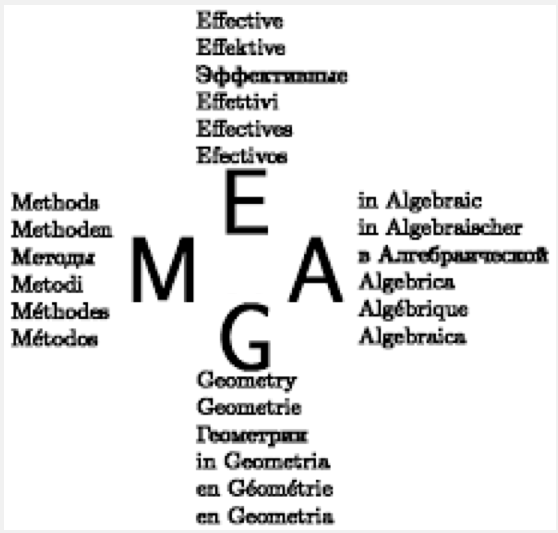The fourteenth conference MEGA, Université Nice Sophia Antipolis, Nice (France), June 12 – 16, 2017
This volume collects the papers presented in the occasion of the MEGA (Effective Methods in Algebraic Geometry) conference held in Nice (France) from June 12th to 16th, 2017. The volume was open to original research contributions presented in the Conference and also to further contributions. According to the MEGA tradition, Algebraic Geometry is interpreted broadly, including, among other topics, symbolic computations, commutative algebra, polynomial optimization, combinatorial techniques, tropical geometry and applications.
The papers in this volume can be divided along the following themes:
- Effective methods in commutative algebra, Hilbert functions, monomial ideals: papers 1-3;
- Projective Geometry and Singularities, Vector bundles on Projective Spaces: papers 4-6;
- Tropical Geometry, Combinatorics of Polyhedra and its use in Optimization problems: papers 7-10;
- Real solutions to polynomial equations: papers 11-12.
Hannah Markwig, Eberhard Karls Universität Tübingen, Germany,
Bernard Mourrain, Inria Sophia Antipolis Méditerranée, France,
Giorgio Ottaviani, Università di Firenze, Italy
Conference papers
- On the postulation of lines and a fat line by Thomas Bauer, Sandra Di Rocco, David Schmitz, Tomasz Szemberg, Justyna Szpond ;computes the Hilbert function of projective schemes given by the union of lines and a fat line in $\mathbb{P}^3$, providing evidence for a conjecture of Aladpoosh concerning such schemes in $\mathbb{P}^n$.
- IDEALS OF THE FORM $\textit{I}_1 (XY)$by Joydip Saha, Indranath Sengupta, Gaurab Tripathi tudies Gr ̈obner bases for ideals generated by coefficients of $XY$, where $X$ is a matrix and $Y$ is a column vector.
- Bar code for monomial ideals by Michela Ceria gives a connection between (strongly) stable monomial ideals and integer partitions, through the Bar Code, a bidimensional diagram that allows to represent any finite set of terms of an order ideal.
- CONSTRUCTING EQUIVARIANT VECTOR BUNDLES VIA THE BGG CORRESPONDENCE by Sébastien Posur deals with bounded derived category of $G$-equivariant coherent sheaves on projective space. The author introduces an algorithmic approach to work in this category, and computes all $A_5$-equivariant vector bundle on $\mathbb{P}^4$ which arise this way.
- THE BORDIGA SURFACE AS CRITICAL LOCUS FOR 3–VIEW RECONSTRUCTIONS by Marina Bertolini, Roberto Notari, Christina Turrini concerned with the reconstruction problem in Computer Vision. The classical Bordiga surface is interpreted as the locus where the reconstruction fails, which is called the critical locus.
- Computing the monodromy and pole order filtration on Milnor fiber cohomology of plane curves by Alexandru Dimca and Gabriel Sticlaru studies singularities of plane curves through an arrangement of hyperplanes. The relation to the zero set of Bernstein-Sato polynomial of the defining homogeneous polynomial for the curve is discussed.
- Algorithms for Tight Spans and Tropical Linear Spaces by Simon Hampe, Michael Joswig, Benjamin Schröter presents an algorithm for the computation of a tropical linear space as a polyhedral complex from its Plücker vector, taking advantage of the duality to valuated matroids. Generalizing existing software, the algorithm computes all faces of the polyhedral complex. The authors use their implementation to compute all types of 3-dimensional tropical linear spaces in 8-dimensional space, providing evidence for Speyer’s $f$-vector conjecture.
- The tropical analogue of the Helton–Nie conjecture is true by Xavier Allamigeon, Stephane Gaubert, Mateusz Skomra deals with the conjecture that every convex semialgebraic set is a projection of a spectrahedron, which was recently disproved by Scheiderer. Making use of a connection between tropical spectrahedra and games, the authors show that, unexpectedly, the analogous conjecture in tropical geometry is true.
- AN APPROACH TO CONSTRAINED POLYNOMIAL OPTIMIZATION VIA NONNEGATIVE CIRCUIT POLYNOMIALS AND GEOMETRIC PROGRAMMING by Mareike Dressler, Sadik Iliman, Timo De Wolff ; studies nonnegativity certificates based on sums of nonnegative circuit polynomials via geometric programming methods involving lattice polytopes for constrained polynomial optimization problems.
- BEYOND POLYHEDRAL HOMOTOPIES by Anton Leykin, Josephine Yu provides an algorithmic framework combining tools from tropical geometry and homotopy continuation for solving systems of polynomial equations over series fields. In order to start a homotopy, the tropicalization of a variety is used.
- IMAGINARY PROJECTIONS OF POLYNOMIALS by Thorsten Jörgens, Thorsten Theobald, Timo De Wolff considers the projection of a affine hypersurface onto its imaginary part, which is called imaginary projection. It is shown that the connected components of the complement of the imaginary projections are convex, and some structural properties of these components are proved.
- WARING DECOMPOSITIONS AND IDENTIFIABILITY VIA BERTINI AND MACAULAY2 SOFTWARE by Elena Angelini studies the identifiability over complex numbers versus real numbers for polynomial vectors, in other words studies the identifiability for simultaneous Waring decomposition of symmetric tensors.

